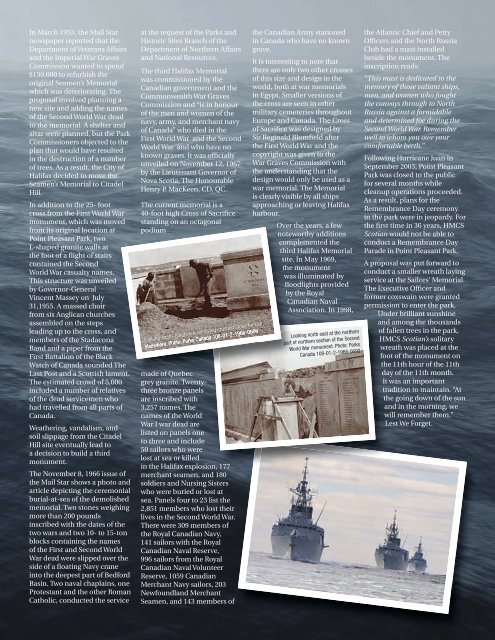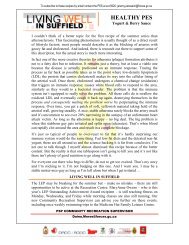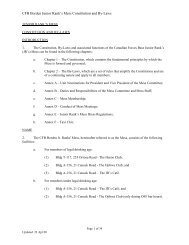We Care!
We Care!
We Care!
You also want an ePaper? Increase the reach of your titles
YUMPU automatically turns print PDFs into web optimized ePapers that Google loves.
In March 1953, the Mail Star<br />
newspaper reported that the<br />
Department of Veterans Affairs<br />
and the Imperial War Graves<br />
Commission wanted to spend<br />
$130,000 to refurbish the<br />
original Seamen’s Memorial<br />
which was deteriorating. The<br />
proposal involved planning a<br />
new site and adding the names<br />
of the Second World War dead<br />
to the memorial. A shelter and<br />
altar were planned, but the Park<br />
Commissioners objected to the<br />
plan that would have resulted<br />
in the destruction of a number<br />
of trees. As a result, the City of<br />
Halifax decided to move the<br />
Seamen’s Memorial to Citadel<br />
Hill.<br />
In addition to the 25- foot<br />
cross from the First World War<br />
monument, which was moved<br />
from its original location at<br />
Point Pleasant Park, two<br />
L-shaped granite walls at<br />
the foot of a flight of stairs<br />
contained the Second<br />
World War casualty names.<br />
This structure was unveiled<br />
by Governor-General<br />
Vincent Massey on July<br />
31,1955. A massed choir<br />
from six Anglican churches<br />
assembled on the steps<br />
leading up to the cross, and<br />
members of the Stadacona<br />
Band and a piper from the<br />
First Battalion of the Black<br />
Watch of Canada sounded The<br />
Last Post and a Scottish lament.<br />
The estimated crowd of 5,000<br />
included a number of relatives<br />
of the dead servicemen who<br />
had travelled from all parts of<br />
Canada.<br />
<strong>We</strong>athering, vandalism, and<br />
soil slippage from the Citadel<br />
Hill site eventually lead to<br />
a decision to build a third<br />
monument.<br />
The November 8, 1966 issue of<br />
the Mail Star shows a photo and<br />
article depicting the ceremonial<br />
burial-at-sea of the demolished<br />
memorial. Two stones weighing<br />
more than 200 pounds<br />
inscribed with the dates of the<br />
two wars and two 10- to 15-ton<br />
blocks containing the names<br />
of the First and Second World<br />
War dead were slipped over the<br />
side of a floating Navy crane<br />
into the deepest part of Bedford<br />
Basin. Two naval chaplains, one<br />
Protestant and the other Roman<br />
Catholic, conducted the service<br />
at the request of the Parks and<br />
Historic Sites Branch of the<br />
Department of Northern Affairs<br />
and National Resources.<br />
The third Halifax Memorial<br />
was commissioned by the<br />
Canadian government and the<br />
Commonwealth War Graves<br />
Commission and “is in honour<br />
of the men and women of the<br />
navy, army, and merchant navy<br />
of Canada” who died in the<br />
First World War and the Second<br />
World War and who have no<br />
known graves. It was officially<br />
unveiled on November 12, 1967<br />
by the Lieutenant Governor of<br />
Nova Scotia, The Honourable<br />
Henry P. MacKeen, CD, QC.<br />
The current memorial is a<br />
40-foot high Cross of Sacrifice<br />
standing on an octagonal<br />
podium<br />
made of Quebec<br />
grey granite. Twentythree<br />
bronze panels<br />
are inscribed with<br />
3,257 names. The<br />
names of the World<br />
War I war dead are<br />
listed on panels one<br />
to three and include<br />
50 sailors who were<br />
lost at sea or killed<br />
in the Halifax explosion, 177<br />
merchant seamen, and 180<br />
soldiers and Nursing Sisters<br />
who were buried or lost at<br />
sea. Panels four to 23 list the<br />
2,851 members who lost their<br />
lives in the Second World War.<br />
There were 309 members of<br />
the Royal Canadian Navy,<br />
141 sailors with the Royal<br />
Canadian Naval Reserve,<br />
996 sailors from the Royal<br />
Canadian Naval Volunteer<br />
Reserve, 1059 Canadian<br />
Merchant Navy sailors, 203<br />
Newfoundland Merchant<br />
Seamen, and 143 members of<br />
the Canadian Army stationed<br />
in Canada who have no known<br />
grave.<br />
It is interesting to note that<br />
there are only two other crosses<br />
of this size and design in the<br />
world, both at war memorials<br />
in Egypt. Smaller versions of<br />
the cross are seen in other<br />
military cemeteries throughout<br />
Europe and Canada. The Cross<br />
of Sacrifice was designed by<br />
Sir Reginald Blomfield after<br />
the First World War and the<br />
copyright was given to the<br />
War Graves Commission with<br />
the understanding that the<br />
design would only be used as a<br />
war memorial. The Memorial<br />
is clearly visible by all ships<br />
approaching or leaving Halifax<br />
harbour.<br />
Over the years, a few<br />
noteworthy additions<br />
complemented the<br />
third Halifax Memorial<br />
site. In May 1969,<br />
the monument<br />
was illuminated by<br />
floodlights provided<br />
by the Royal<br />
Canadian Naval<br />
Association. In 1998,<br />
the Atlantic Chief and Petty<br />
Officers and the North Russia<br />
Club had a mast installed<br />
beside the monument. The<br />
inscription reads:<br />
“This mast is dedicated to the<br />
memory of those valiant ships,<br />
men, and women who fought<br />
the convoys through to North<br />
Russia against a formidable<br />
and determined foe during the<br />
Second World War. Remember<br />
well to whom you owe your<br />
comfortable berth.”<br />
Following Hurricane Juan in<br />
September 2003, Point Pleasant<br />
Park was closed to the public<br />
for several months while<br />
cleanup operations proceeded.<br />
As a result, plans for the<br />
Remembrance Day ceremony<br />
in the park were in jeopardy. For<br />
the first time in 36 years, HMCS<br />
Scotian would not be able to<br />
conduct a Remembrance Day<br />
Parade in Point Pleasant Park.<br />
A proposal was put forward to<br />
conduct a smaller wreath laying<br />
service at the Sailors’ Memorial.<br />
The Executive Officer and<br />
former coxswain were granted<br />
permission to enter the park.<br />
Under brilliant sunshine<br />
and among the thousands<br />
of fallen trees in the park,<br />
HMCS Scotian’s solitary<br />
wreath was placed at the<br />
foot of the monument on<br />
the 11th hour of the 11th<br />
day of the 11th month.<br />
It was an important<br />
tradition to maintain. “At<br />
the going down of the sun<br />
and in the morning, we<br />
will remember them.”<br />
Lest <strong>We</strong> Forget.
















